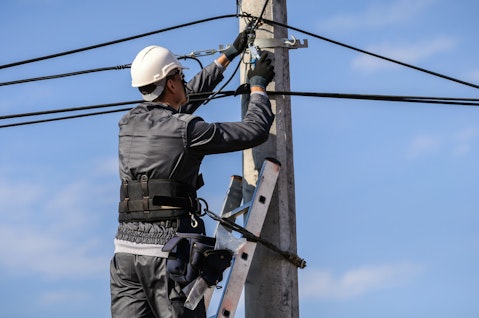Dycom Industries, Inc. (NYSE:DY) Q2 2024 Earnings Call Transcript August 23, 2023
Dycom Industries, Inc. beats earnings expectations. Reported EPS is $2.03, expectations were $1.66.
Operator: Good day and welcome to Dycom Industries, Inc. Second Quarter Results Conference Call. [Operator Instructions] Please be advised that today’s conference is being recorded. I would now like to hand the conference over to your speaker, Mr. Steven Nielsen. President and Chief Executive Officer. Please go ahead, sir.
Steven Nielsen: Thank you, operator. Good morning, everyone. Thank you for attending this conference call to review our second quarter fiscal 2024 results. Going to Slide 2. During this call, we will be referring to a slide presentation which can be found on our website’s Investor Center main page. Relevant slides will be identified by number throughout our presentation. Today, we have on the call Drew DeFerrari, our Chief Financial Officer; and Ryan Urness, our General Counsel. Now I will turn the call over to Ryan Urness.
Ryan Urness: Thank you, Steve. All forward-looking statements made during this conference call are provided pursuant to the Safe Harbor provisions of the Private Securities Litigation Reform Act of 1995. Forward-looking statements include all comments reflecting our expectations, assumptions or beliefs about future events or performance that do not relate to historical periods. These forward-looking statements are subject to risks and uncertainties which may cause actual results to differ materially from current projections, including those risks described in our annual report on Form 10-K filed March 3, 2023 and together with our other filings with the U.S. Securities and Exchange Commission. Forward-looking statements are made solely as of the original broadcast date of this conference call and we assume no obligation to update any forward-looking statements. Steve?
Steven Nielsen: Thanks, Ryan. Now moving to Slide 4 and a review of our second quarter results. As we review our results, please note that in our comments today and in the accompanying slides, we reference certain non-GAAP measures. We refer you to the quarterly report section of our website for a reconciliation of these non-GAAP measures to their corresponding GAAP measures. Now for the quarter. Revenue was $1.042 billion, an organic increase of 7.1%. As we deployed gigabit wireline networks, wireless/wireline converged networks and wireless networks, this quarter reflected an increase in demand from 4 of our top 5 customers. Gross margin was 20.3% of revenue and increased 234 basis points compared to the second quarter of fiscal 2023.
General and administrative expenses were 8.1% of revenue and all of these factors produced adjusted EBITDA of $130.8 million or 12.6% of revenue and earnings per share of $2.03 compared to $1.46 in the year ago quarter. Liquidity was strong at $685.9 million. And last Friday, we acquired Bigham Cable Construction, a provider of telecommunications construction services in the Southeastern United States for a purchase price of $127 million. Bigham generated revenues of approximately $140 million over the last year and expands our ability to further address significant growth opportunities in rural broadband deployments. And finally, as our most recent share repurchase authorization has expired, our Board has newly authorized $150 million in share repurchases.
Now going to Slide 5. Today, major industry participants are constructing or upgrading significant wireline networks across broad sections of the country. These wireline networks are generally designed to provision gigabit network speeds to individual consumers and businesses either directly or wirelessly using 5G technologies. Industry participants have stated their belief that a single high-capacity fiber network can most cost effectively deliver services to both consumers and businesses, enabling multiple revenue streams from a single investment. This view is increasing the appetite for fiber deployments and we believe that the industry effort to deploy high capacity fiber networks continues to meaningfully broaden the set of opportunities for our industry.
Increasing access to high-capacity telecommunications continues to be crucial to society, especially for rural America. The infrastructure investment and Jobs Act includes over $40 billion for the construction of Royal Communications networks in unserved and underserved areas across the country. This represents an unprecedented level of support. In addition, substantially all states have commenced programs that will provide funding for telecommunications networks even prior to the initiation of funding under the Infrastructure Act. We are providing program management, planning, engineering and design, aerial, underground and wireless construction and fulfillment services for gigabit deployments. These services are being provided across the country in numerous geographic areas to multiple customers.
These deployments include networks consisting entirely of wired network elements and converged wireless/wireline multiuse networks. Fiber network deployment opportunities are increasing in rural America as new industry participants respond to emerging societal initiatives. We continue to provide integrated planning, engineering and design, procurement and construction and maintenance services to several industry participants. Macroeconomic conditions, including those impacting the cost of capital, may influence the execution of some industry plans. In addition, the market for labor remains tight in many regions around the country. Automotive and equipment supply chains remain challenged, particularly for the large truck chassis required for specialty equipment, prices for capital equipment continue to increase.
It remains to be seen how long these conditions may persist. We expect demand to continue to fluctuate amongst customers. For several customers, deployments are increasing into next year. For others, capital expenditures have been more heavily weighted towards the first half of this year. And accordingly, they appear to be managing budgets closely through the end of this year. We are encouraged by recent longer-term industry financings. These financings have expanded the pool of capital available to fund future industry growth. Within this context, we remain confident that our scale and financial strength position us well to deliver valuable service to our customers. Moving to Slide 6. During the quarter, revenue increased 7.1%. Our top 5 customers combined, produced 59.2% of revenue, decreasing 2.3% organically.
Demand increased from 4 of our top 5 customers. All other customers increased 24.6% organically. AT&T was our largest customer at 16.7% of total revenue or $174.3 million. Lumen was our second largest customer at 15.6% of revenue or $162.5 million. Lumen grew organically 56.5%, excluding operations sold to Brightspeed from the year ago period. This was our sixth consecutive quarter of organic growth with Lumen. Revenue from Comcast was $119.5 million or 11.5% of revenue. Comcast was Dycom’s third largest customer and grew organically 6.9%. Verizon was our fourth largest customer at $104.9 million or 10.1% of revenue. Ryzen grew 29.8% organically. And finally, a customer who has requested that our name not be disclosed, was our fifth largest customer at $55.3 million or 5.3% of revenue.
This customer grew 68.6% organically. This is the 18th consecutive quarter where all of our other customers in aggregate, excluding the top 5 customers, have grown organically. It is the first quarter since our October 2014 quarter where our top 5 customers have represented less than 60% of total revenue, an encouraging sign of increasing customer breadth and opportunity. Of note, fiber construction revenue from electric utilities was $82.7 million in the quarter and grew organically 3.6%. We have extended our geographic reach and expanded our program management and network planning services. In fact, over the last several years, we believe we have meaningfully increased the longer-term value of our maintenance and operations business, a trend which we believe will parallel our deployment of gigabit wireline direct and wireless/wireline converged networks as those deployments dramatically increase the amount of outside plant network that must be extended and maintained.
Now going to Slide 7. Backlog at the end of the second quarter was $6.207 billion versus $6.316 billion at the end of the April 2023 quarter, a decrease of $109 million. Of this backlog, approximately $3.523 billion is expected to be completed in the next 12 months. Backlog activity during the second quarter reflects solid performance as we booked new work and renewed existing work. We continue to anticipate substantial future opportunities across a broad array of our customers. During the quarter, we received from Frontier, a fiber construction agreement for California, Texas, Illinois, Michigan, Indiana, Ohio, New York, Connecticut, Pennsylvania and Florida. For Brightspeed a fiber construction agreement for Pennsylvania, New Jersey, Virginia and North Carolina.
From Charter, rural fiber construction agreements in Missouri and Florida. For Windstream, fiber construction agreements in Georgia. And from AT&T, a utility line locating agreement for Arkansas. Headcount was 15,147. Now, I will turn the call over to Drew for his financial review and outlook.
Drew DeFerrari: Thanks, Steve and good morning, everyone. Going to Slide 8. Contract revenues were $1.042 billion and organic revenue increased 7.1%. Adjusted EBITDA was $130.8 million or 12.6% of revenue compared to $104.7 million or 10.8% of revenue. The adjusted EBITDA percentage increased 179 basis points compared [indiscernible] ’23 from improved operating performance on the higher level of revenue in the quarter. Gross margin was 20.3% of revenue compared to 17.9% in Q2 ’23. G&A expense was 8.1% of revenue compared to 7.5% in Q2 ’23 and Net income was $2.03 per share compared to $1.46 per share in Q2 last year. The increase in earnings reflects higher adjusted EBITDA and lower amortization and higher gains on asset sales, partially offset by higher depreciation, stock-based compensation, interest expense and taxes.
Going to Slide 9. Our financial position and balance sheet remains strong. We ended Q2 with $500 million of senior notes, $323.75 million of term loan and no revolver borrowings. Cash and equivalents were $83.4 million and liquidity was strong at $685.9 million. Our capital allocation prioritizes organic growth followed by M&A and opportunistic share repurchases within the context of our historical range of net leverage. Last Friday, we acquired Bigham Cable Construction for a purchase price of $127 million. And this week, our Board of Directors approved a new $150 million authorization for share repurchases through February 2025. This authorization replaces the remaining amount from our prior authorization. Going to Slide 10. Cash flows provided by operating activities were $56.3 million in Q2.
Capital expenditures were $40 million, net of disposal proceeds and gross CapEx was $51 million. The combined DSOs of accounts receivable and net contract assets was 111 days, an increase of 5 days sequentially. Going to Slide 11. As we look ahead to the quarter ending October 28, 2023, we expect organic contract revenues to be in line with Q3 of last year. In addition, we expect approximately $30 million of acquired revenues from Bigham Cable construction in Q3 2024. We also expect non-GAAP adjusted EBITDA percentage of contract revenues to increase 50 to 100 basis points as compared to Q3 2023. Additionally, we expect $6.1 million of total amortization expense, $13.3 million of net interest expense, a 26% effective income tax rate and 29.7 million diluted shares.
Now, I will turn the call back to Steve.
See also Analysts on Wall Street Lower Ratings for These 10 Stocks and 15 States with the Highest College Tuition and Fees.
Q&A Session
Follow Dycom Industries Inc (NYSE:DY)
Follow Dycom Industries Inc (NYSE:DY)
Receive real-time insider trading and news alerts
Steven Nielsen: Thanks, Drew. Moving to Slide 12. This quarter, we experienced solid activity and capitalized on our significant strengths. First and foremost, we maintain significant customer presence throughout our markets. We are encouraged by the breadth in our business. Our extensive market presence has allowed us to be at the forefront of evolving industry opportunities. Telephone companies are deploying fiber-to-the-home to enable gigabit high-speed connections. Rural electric utilities are doing the same. Dramatically increased speeds for consumers are being provisioned and consumer data usage is growing, particularly upstream. Wireless construction activity in support of newly available spectrum bands continues this year.
Federal and state support for rural deployments of communications networks is dramatically increasing in scale and duration. Cable operators are increasing fiber deployments in rural America, capacity expansion projects are underway. Customers are consolidating supply chains, creating opportunities for market share growth and increasing the long-term value of our maintenance and operations business. As our nation and industry navigate economic uncertainty, we remain encouraged that a substantial number of our customers are committed to multiyear capital spending initiatives. We are confident in our strategies, the prospects for our company, the capabilities of our dedicated employees and the experience of our management team. Before we take questions, I want to welcome our new employees at Bigham Cable Construction.
We look forward to growing together. Now operator, we will open the call for questions.
Operator: [Operator Instructions] And that will come from the line of Adam Thalhimer with Thompson & Davis.
Adam Thalhimer: Congrats on the good quarter and the acquisition. Steve or Drew, from the customers that are going to be a touch weaker in the back half of this year, when do you think activity picks back up? Is it possible in your fiscal Q4?
Steven Nielsen: Yes, Adam, I think we’ve seen other environments where people that had strong first halves. They closely manage their budget going into the end of the year. And then as I look forward to more normalized activity in the following year, there’s certainly a possibility that, that activity could pick up. We’ve seen that before.
Adam Thalhimer: And then for Bigham, can you comment on — do they have a specific top customer? Are there any large contracts that you’re picking up? And maybe you can comment on the acquisition process?
Steven Nielsen: Yes. They have historically had a long successful relationship with Charter in the Southeast. They also work for a number of electric co-ops. So we think it’s a good expansion of the business that we do with Charter. We’ve obviously done lots of work in the Southeast. There was not a process. These are folks that we’ve known for a long time and respected. And so it just made sense for both of us to get together when we did.
Operator: [Operator Instructions] And that will come from the line of Brent Thielman with D.A. Davidson.
Brent Thielman: Great quarter. Steve, any additional color just on the strong improvement in margins almost 200 basis points over last year. I guess just asking especially in consideration that kind of some of the slower demand you saw from a few larger customers.
Steven Nielsen: Yes. I think we are pleased with the margin performance. We’ve actually, over the last 16 consecutive quarter, both gross and EBITDA margins have increased year-over-year. If you look at the guidance, we expect that to continue for the October quarter. I think there are a number of things that are — have been helpful. I mean, clearly, we’ve had lots of organic growth. We’ve always talked about having good distribution across top customers but we’ve also had great growth out of the top 5. So that’s been helpful. We talked about some headwinds that have abated over the last, call it, 2 to 3 quarters. So that’s also been helpful. And I just think that in general, the industry is in a very healthy place but always — we could always do better. We’re working hard to improve them but we are pleased with our progress.





